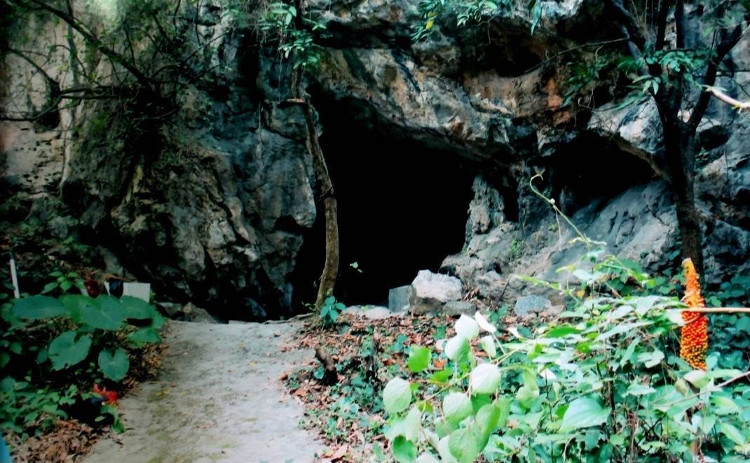Hai Duong: Discovering an ancient tomb in a cave over 3,000 years old, there are many remains
Permitted by the Ministry of Culture, Sports and Tourism, Vietnam Archaeological Association recently excavated an ancient tomb at the Go Cave (Bich Nhi 3 Area, Minh Tan Town, Kinh Mon District, Hai District). Ocean).
The Goat Cave is located in a complex of rocky mountains, land mountains in An Phu - Kinh Chu - Nham Duong district of Kinh Mon district, Hai Duong province, recognized by the State as a special National Monument.

Goat Cave (Hang Ma), where there is an ancient tomb.
The Goat Cave (also known as Ma Cave) is a large cave, 8.8m deep, 7m wide, 5.4m high, turning 10 ° north to the east, with 2 adjacent caves and arches inside. round, 2m and 2.5m in diameter. Hang is located right next to the ring road of the quarry of Vicem Hoang Thach Cement Company. The cave is about 4km from Nham Duong Pagoda, a special national monument along the flight path.
In 2013, a resident of Bich Nhi 3, Minh Tan town, Kinh Mon district, Hai Duong province searched for stalactites, stumbling upon a grave buried in a rock cavity at Go Cave. He used cement mounted gravestones and occasionally lit incense. Recently, Assoc.Prof.Dr. Nguyen Lan Cuong and Vietnamese archaeologists on the study of ancient artifacts at Nham Duong pagoda, where the discovery of Pongo remains (orangutans) is over 30,000 years old. Assoc. Nguyen Lan Cuong was informed by the leader of Kinh Mon District People's Committee about the grave in Goat Cave. He and his colleagues went to survey and found this is an ancient tomb. What is special is that the stalactites that have spent thousands of years covered the grave. Assoc. Nguyen Lan Cuong did the procedure, proposed to excavate this ancient tomb.

Jaw bone of the old.
Permitted by the Ministry of Culture - Sports & Tourism, in the middle of December 2017, Vietnam Archaeological Association in collaboration with Hai Duong Museum and Kinh Mon District Cultural Office excavated the ancient tomb at Go Cave. Through excavation, archaeologists have discovered the remains of people and two small ceramic pots are burial items. The strange thing is that stalactites overlap on the remains of the fossil's fossil and the ceramic pot makes a solid block.
The bones in the grave were partially broken, due to the local people taking stalactites. Thankfully, the lower jaw with some teeth is still attached to the jaw, some skull fragments and the cranial bones: the thighs, the pestles, the arms are preserved.It is likely that the dead are buried as a pillow , because archaeologists find that the bones of the feet are close to the piece of skull, femur, and pestle, the arms are almost parallel to each other. Based on the height of the lower jaw, the femoral column, the wear of the teeth, we believe that this is likely the remains of a man, about 30-40 years old.
The shoulder of the ceramic pot has not been separated to learn about the pattern, but based on the design of the ceramic pot, the structure of the ceramic bone is quite rough, many archaeologists have an opinion of the date of this tomb in the early stages. Metal period, about 3,000 to 3,500 years ago.

Assoc.Nguyen Lan Cuong with fossilized bones.
After excavation of the grave, archaeologists have dug a survey hole 1 meter wide, right at the entrance of the cave. At 0.7m depth, there are 3 occipital bones of a skull. Goat Cave has a very favorable position for the ancients to live. The potential of archeology here is very rich. Therefore, the archeology team filled the reconnaissance hole. It is expected to continue asking for permission from the Ministry of Culture - Sports & Tourism to excavate the Goat Cave in 2018.
All artifacts collected in Goat Cave have been transferred to Nham Duong Pagoda, stored in glass cabinets, with ancient and animal teeth found in the Holy Hall and stone and earthenware pottery. bronze . found in Nham Duong mountain area.
Archaeologists are expected to send a tooth abroad to predict the human race of the ancient tomb in the Goat Cave, to accurately date the Accelerator Mass Spectrometry (AMS) of the reclining people. Goat Cave has been around for thousands of years.
The discovery and excavation of Goat Cave is valuable evidence to learn about the living of the ancients in An Phu - Kinh Chu - Nham Duong district of Kinh Mon district, Hai Duong province, which has been recognized by the State as Di. National special.
- The skeleton is nearly two meters in the tomb of 5,000 years in China
- Go find the tomb of Kinh Duong Vuong
- The 4,000-year-old couple is in a close posture in an ancient tomb full of gold
- The ancient tomb on Buoi Street is over 1,000 years old?
- Mystery about ancient tombs for hundreds of years of remains in Nghe An
- 2,000-year-old tomb in Mexico
- Horseman remains in the tomb 1,500 years old
- Excavation of the pre-Inca aristocratic tomb
- The woman's remains have hair and nails left after 900 years
- Mysterious beauty in the ancient tomb of the king is full of gold
- Detecting traces of people near Con Moong cave
- Egyptian remains 3300 years with the ring
 Discovered an ancient centipede fossil 99 million years old
Discovered an ancient centipede fossil 99 million years old Discovered bat-like dinosaurs in China
Discovered bat-like dinosaurs in China Discovered a 200-year-old bronze cannon of the coast
Discovered a 200-year-old bronze cannon of the coast Discover 305 million-year-old spider fossils
Discover 305 million-year-old spider fossils